Dynamic Process and Damage Evaluation Subject to Explosion Consequences Resulting from a LPG Tank Trailer Accident
Abstract
:1. Introduction
2. Case Analysis and Numerical Method
2.1. Case Analysis
2.2. Numerical Procedure
2.2.1. Governing Equation
2.2.2. Case-Based Modeling
2.2.3. Boundary Condition
2.2.4. Assumptions Used in Simulation
- For the LPG tank trailer in the process of leakage, the leakage rate is set as a constant rate with continuous leakage.
- The air and vapor cloud explosion area is set as incompressible fluid, showing a turbulent state.
- Leaked gas is regarded as the ideal gas, which should conform to the equation of state; it has no chemical reaction or multicomponent in the dispersion process.
- The environment remains the same regarding wind speed and direction.
- The structure is regarded as a rigid body and the influence of fluid-structure coupling is not considered.
2.3. Model Validation
3. Results and Discussion
3.1. Dynamic Evolution and Characteristics of LPG Tank Trailer Explosion
3.2. Mechanical Damages Subject to Shock Wave Propagation Process
3.3. Distribution and Fluctuation of Heat Flux in LPG Explosion Process
4. Conclusions
- Potential explosive energy is accumulated around the circle section of expressway and becomes a heavy gas characteristic of LPG/air mixture dispersion. The LPG explosion’s effects on buildings depend strongly on the surrounding arrangement. In this case, the shock wave propagates in the direction of residential buildings on both sides of the expressway. The peak overpressure induced by the shock wave is enough to cause extensive damage to nearby structures.
- The turbulence intensity caused by the obstacles significantly promotes an increase in the shock wave propagation speed. The shock wave reaches the residential buildings in approximately 899.6 ms, within the influence of surrounding obstacles at an elevated block ratio. The pressure rise rate is over 100 Pa/ms, which indicates that the shock wave has the strongest effect on the obstacle in a very short time.
- The radiative heat flux generated by the LPG explosive fireball increases as the tank trailer load mass increases, and the temperature rise rate from heat flux grows more slowly than the maximum rate of pressure rise. The influence of the LPG mass on the evolution of the explosive fireball is remarkably reflected in the damage range of heat flux. The longer the LPG dispersion time takes, the larger the vertical diameter of fireball and the wider range from LPG explosion thermal hazards.
- The dynamic response of cracks on building structures formed by initial explosion intensifies the surrounding destruction of the shock wave energy during the secondary explosion, resulting in a greater damage in shock-wave-driven overpressure on the far-field. In this case of LPG tank trailer explosion, the lethal distance of injury from the explosive fireball is significantly worse than that of overpressure injury, while the damage range from the shock wave is even longer than that of heat flux extension.
Author Contributions
Funding
Institutional Review Board Statement
Informed Consent Statement
Data Availability Statement
Acknowledgments
Conflicts of Interest
References
- Bernatik, A.; Rehak, D.; Cozzani, V.; Foltin, P.; Valasek, J.; Paulus, F. Integrated Environmental Risk Assessment of Major Accidents in the Transport of Hazardous Substances. Sustainability 2021, 13, 11993. [Google Scholar] [CrossRef]
- Beck, M. The Risk Implications of Globalisation: An Exploratory Analysis of 105 Major Industrial Incidents (1971–2010). Int. J. Environ. Res. Public Health 2016, 13, 309. [Google Scholar] [CrossRef] [PubMed]
- Jia, X.; He, R.; Zhang, C.; Chai, H. A Bi-Level Programming Model of Liquefied Petroleum Gas Transportation Operation for Urban Road Network by Period-Security. Sustainability 2018, 10, 4714. [Google Scholar] [CrossRef]
- Salamonowicz, Z.; Majder-Lopatka, M.; Dmochowska, A.; Piechota-Polanczyk, A.; Polanczyk, A. Numerical Description of Jet and Duct Ventilation in Underground Garage after LPG Dispersion. Processes 2022, 10, 53. [Google Scholar] [CrossRef]
- Brzezinska, D.; Markowski, A. Experimental investigation and CFD modelling of the internal car park environment in case of accidental LPG release. Process Saf. Environ. Prot. 2017, 110, 5–14. [Google Scholar] [CrossRef]
- Pontiggia, M.; Landucci, G.; Busini, V.; Derudi, M.; Alba, M.; Saioni, M.; Bonvicini, S.; Cozzani, V.; Rota, R. CFD model simulation of LPG dispersion in urban areas. Atmos. Environ. 2011, 45, 3913–3923. [Google Scholar] [CrossRef]
- Wang, K.; Hu, Q.; Qian, X.; Li, M.; Shi, T. Cause analysis and damage mechanism of explosive destruction with case investigation involving LPG tank trailer. Eng. Fail. Anal. 2022, 133, 106002. [Google Scholar] [CrossRef]
- Hu, Q.; Qian, X.; Shen, X.; Zhang, Q.; Ma, C.; Pang, L.; Liang, Y.; Feng, H.; Yuan, M. Investigations on vapor cloud explosion hazards and critical safe reserves of LPG tanks. J. Loss Prev. Process Ind. 2022, 80, 104904. [Google Scholar] [CrossRef]
- Scarponi, G.; Landucci, G.; Birk, A.; Cozzani, V. LPG vessels exposed to fire: Scale effects on pressure build-up. J. Loss Prev. Process Ind. 2018, 56, 342–358. [Google Scholar] [CrossRef]
- Gabhane, L.R.; Kanidarapu, N. Environmental Risk Assessment Using Neural Network in Liquefied Petroleum Gas Terminal. Toxics 2023, 11, 348. [Google Scholar] [CrossRef]
- Wang, K.; Liu, Z.; Qian, X.; Huang, P. Long-term consequence and vulnerability assessment of thermal radiation hazard from LNG explosive fireball in open space based on full-scale experiment and PHAST. J. Loss Prev. Process Ind. 2017, 46, 13–22. [Google Scholar] [CrossRef]
- Guo, B.; Gao, J.; Hao, B.; Ai, B.; Hong, B.; Jiang, X. Experimental and Numerical Study on the Explosion Dynamics of the Non-Uniform Liquefied Petroleum Gas and Air Mixture in a Channel with Mixed Obstacles. Energies 2022, 15, 7999. [Google Scholar] [CrossRef]
- Yi, H.; Feng, Y.; Park, H.; Wang, Q. Configuration predictions of large liquefied petroleum gas (LPG) pool fires using CFD method. J. Loss Prev. Process Ind. 2020, 65, 104099. [Google Scholar] [CrossRef]
- Comsawang, P.; Nanetoe, S.; Soponpongpipat, N. Co-Firing of Sawdust and Liquid Petroleum Gas in the Application of a Modified Rocket Stove. Processes 2020, 8, 112. [Google Scholar] [CrossRef]
- Bi, M.; Ren, J.; Zhao, B.; Che, W. Effect of fire engulfment on thermal response of LPG tanks. J. Hazard. Mater. 2011, 192, 874–879. [Google Scholar] [CrossRef]
- Tschirschwitz, R.; Krentel, D.; Kluge, M.; Habib, E.; Kohlhoff, H.; Krüger, S.; Neumann, P.; Storm, S.; Rudolph, M.; Schoppa, A.; et al. Experimental investigation of consequences of LPG vehicle tank failure under fire conditions. J. Loss Prev. Process Ind. 2018, 56, 278–288. [Google Scholar] [CrossRef]
- Wang, K.; He, Y.; Liu, Z.; Qian, X. Experimental study on optimization models for evaluation of fireball characteristics and thermal hazards induced by LNG vapor cloud explosions based on colorimetric thermometry. J. Hazard. Mater. 2019, 366, 282–292. [Google Scholar] [CrossRef]
- Zhou, X.; Hao, Y.; Yang, J.; Xing, Z.; Xue, H.; Huang, Y. Study of the Thermal Radiation Hazard from a Combustible Gas Fireball Resulting from a High-Pressure Gas Pipeline Accident. Processes 2023, 11, 886. [Google Scholar] [CrossRef]
- Bhisham, K.; Dhurandher; Kumar, R.; Dhiman, A. Impact Assessment of Thermal Radiation Hazard from LPG Fireball. Procedia Earth Planet. Sci. 2015, 11, 499–506. [Google Scholar]
- Wang, K.; Shi, T.; He, Y.; Li, M.; Qian, X. Case analysis and CFD numerical study on gas explosion and damage processing caused by aging urban subsurface pipeline failures. Eng. Fail. Anal. 2019, 97, 201–219. [Google Scholar] [CrossRef]
- Sun, D.; Cao, J.; Dai, L.; Li, R.; Liu, Y. Investigation of Formation Process and Intensity of Coal and Gas Outburst Shockwave. Processes 2023, 11, 659. [Google Scholar] [CrossRef]
- Wang, K.; Liu, Z.; Qian, X.; Li, M.; Huang, P. Comparative study on blast wave propagation of natural gas vapor cloud explosions in open space based on a full-scale experiment and PHAST. Energy Fuels 2016, 30, 6143–6152. [Google Scholar] [CrossRef]
- Wang, K.; Ming, Y.; Zhao, H.; Jiao, Y.; Shi, T.; Zhang, Q. Effect of shock-flame interactions on initial damage characteristics in highway tunnel under hazmat tanker truck accident. Tunn. Undergr. Space Technol. 2022, 130, 104763. [Google Scholar] [CrossRef]
- Hernández-Báez, Á.; Torres, E.S.; Amaya-Gómez, R.; Pradilla, D. Oil Onshore Pipeline Quantitative Risk Assessment under Fire and Explosion Scenarios. Processes 2023, 11, 557. [Google Scholar] [CrossRef]
- Wang, K.; Qian, X.; He, Y.; Shi, T.; Zhang, X. Failure analysis integrated with prediction model for LNG transport trailer and thermal hazards induced by an accidental VCE: A case study. Eng. Fail. Anal. 2020, 108, 104350. [Google Scholar] [CrossRef]
- Demichela, M.; Piccinini, N.; Poggio, A. Analysis of an LPG Accidental Release. Process Saf. Environ. Prot. 2004, 82, 128–131. [Google Scholar] [CrossRef]
- Hansen, O.; Johnson, D. Improved far-field blast predictions from fast deflagrations, DDTs and detonations of vapor clouds using FLACS CFD. J. Loss Prev. Process Ind. 2015, 35, 293–306. [Google Scholar] [CrossRef]
- Hansen, O.; Hinze, P.; Engel, D.; Davis, S. Using computational fluid dynamics (CFD) for blast wave predictions. J. Loss Prev. Process Ind. 2010, 23, 885–906. [Google Scholar] [CrossRef]
- Dasgotra, A.; Teja, G.; Sharma, A.; Mishra, K. CFD modeling of large-scale flammable cloud dispersion using FLACS. J. Loss Prev. Process Ind. 2018, 56, 531–536. [Google Scholar] [CrossRef]
- Hansen, O.; Gavelli, F.; Ichard, M.; Davis, S. Validation of FLACS against experimental data sets from the model evaluation database for LNG vapor dispersion. J. Loss Prev. Process Ind. 2010, 23, 857–877. [Google Scholar] [CrossRef]
- Tang, F.; Hu, L.; Delichatsios, M.; Lu, K.; Zhu, W. Experimental study on flame height and temperature profile of buoyant window spill plume from an under-ventilated compartment fire. Int. J. Heat Mass Transf. 2012, 55, 93–101. [Google Scholar] [CrossRef]
- Baker, W.E.; Cox, P.A.; Westine, P.S.; Kulestz, J.J.; Strehlow, R.A. Explosion Hazards and Evaluation; Elsevier Science Publishers: Amsterdam, The Netherlands, 1983. [Google Scholar]
- Kinney, G.F.; Graham, K.J. Explosive Shocks in Air, 2nd Edition; Springer: Berlin/Heidelberg, Germany, 1985. [Google Scholar]
- Center for Chemical Process Safety. Guideline for Chemical Process Quantitative Risk Analysis, 2nd ed.; Wiley-AIChE: New York, NY, USA, 1999. [Google Scholar]
- Henrych, J. The Dynamics of Explosion and Its Use; Elsevier Scientific Publishing Company: Oxford, UK, 1979. [Google Scholar]
- Mills, C. The Design of Concrete Structures to Resist Explosions and Weapon Effects. In Proceedings of the 1st International Conference on concrete for hazard protections, Edinburgh, UK, 27–30 September 1987. [Google Scholar]
- ASTM C 856; Standard Practice for Petrographic Examination of Hardened Concrete. ASTM: West Conshohocken, PA, USA, 1998.
- Yarmolenko, P.S.; Moon, E.J.; Landon, C.; Manzoor, A.; Hochman, D.W.; Viglianti, B.L.; Dewhirst, M.W. Thresholds for thermal damage to normal tissues: An update. Int. J. Hyperth. 2011, 27, 320–343. [Google Scholar] [CrossRef]
- Jacklitsch, B. Criteria for a Recommended Standard: Occupational Exposure to Heat and Hot Environments; 2016–106; Centers for Disease Control and Prevention: Atlanta, GA, USA, 2016. [Google Scholar]
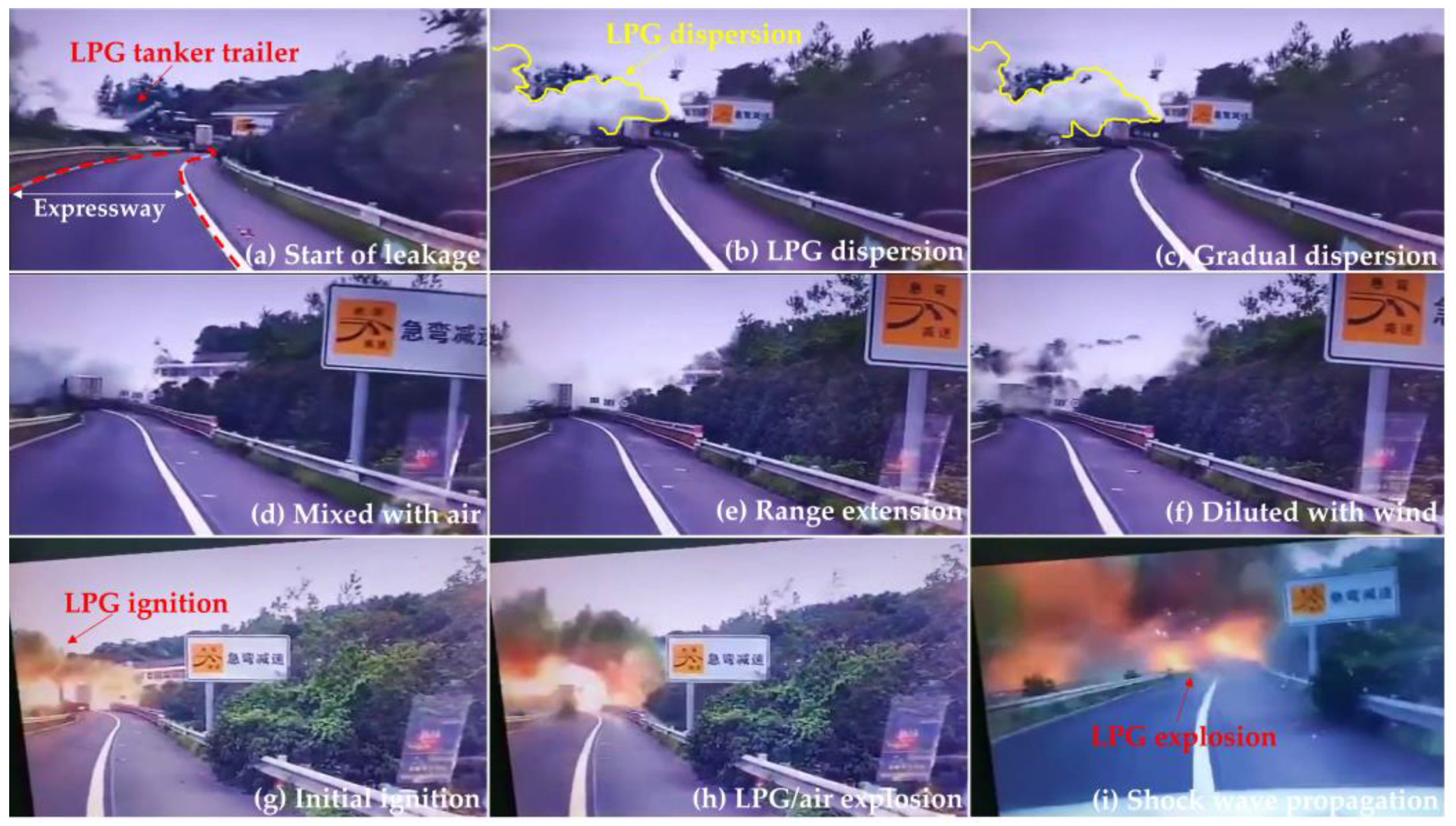

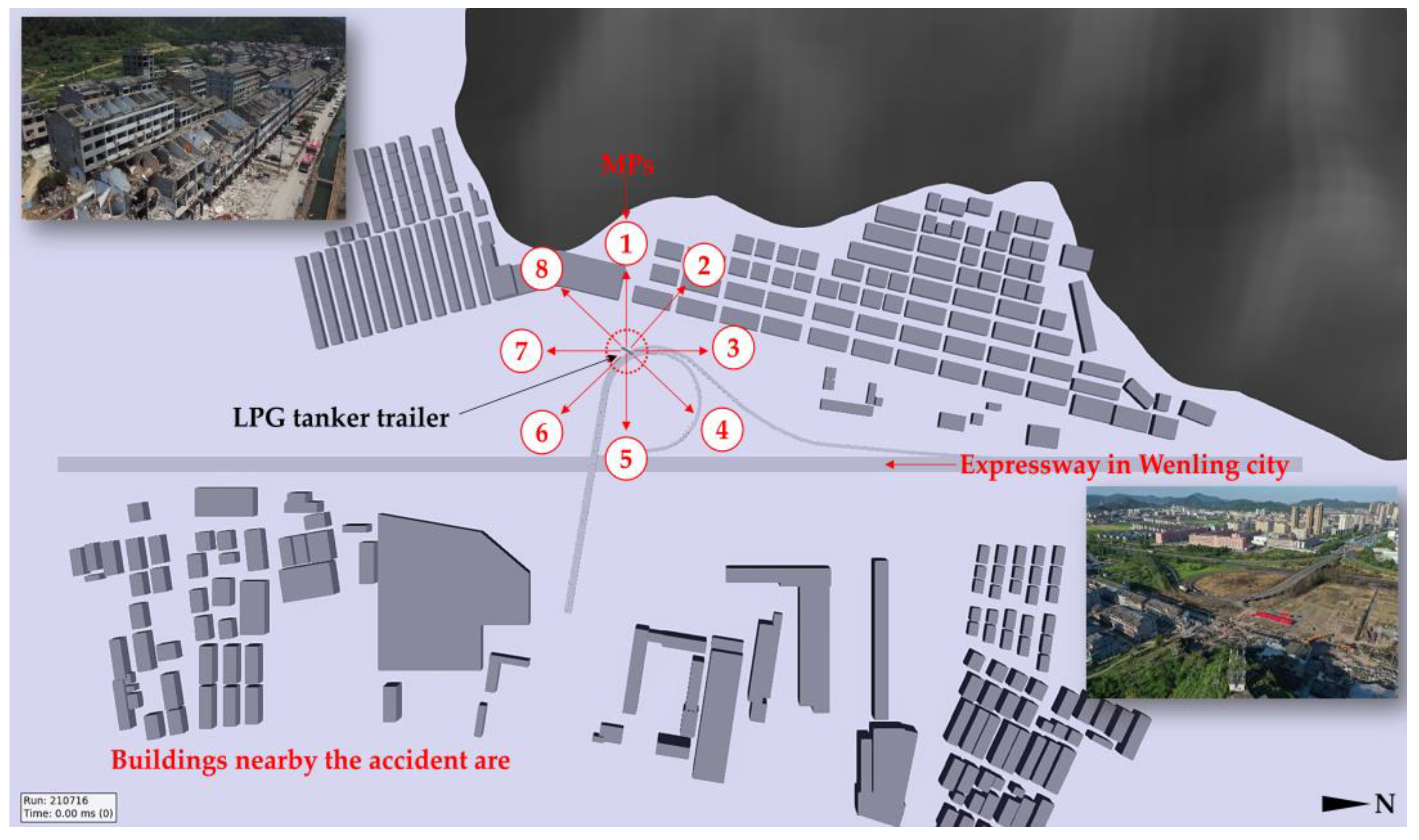



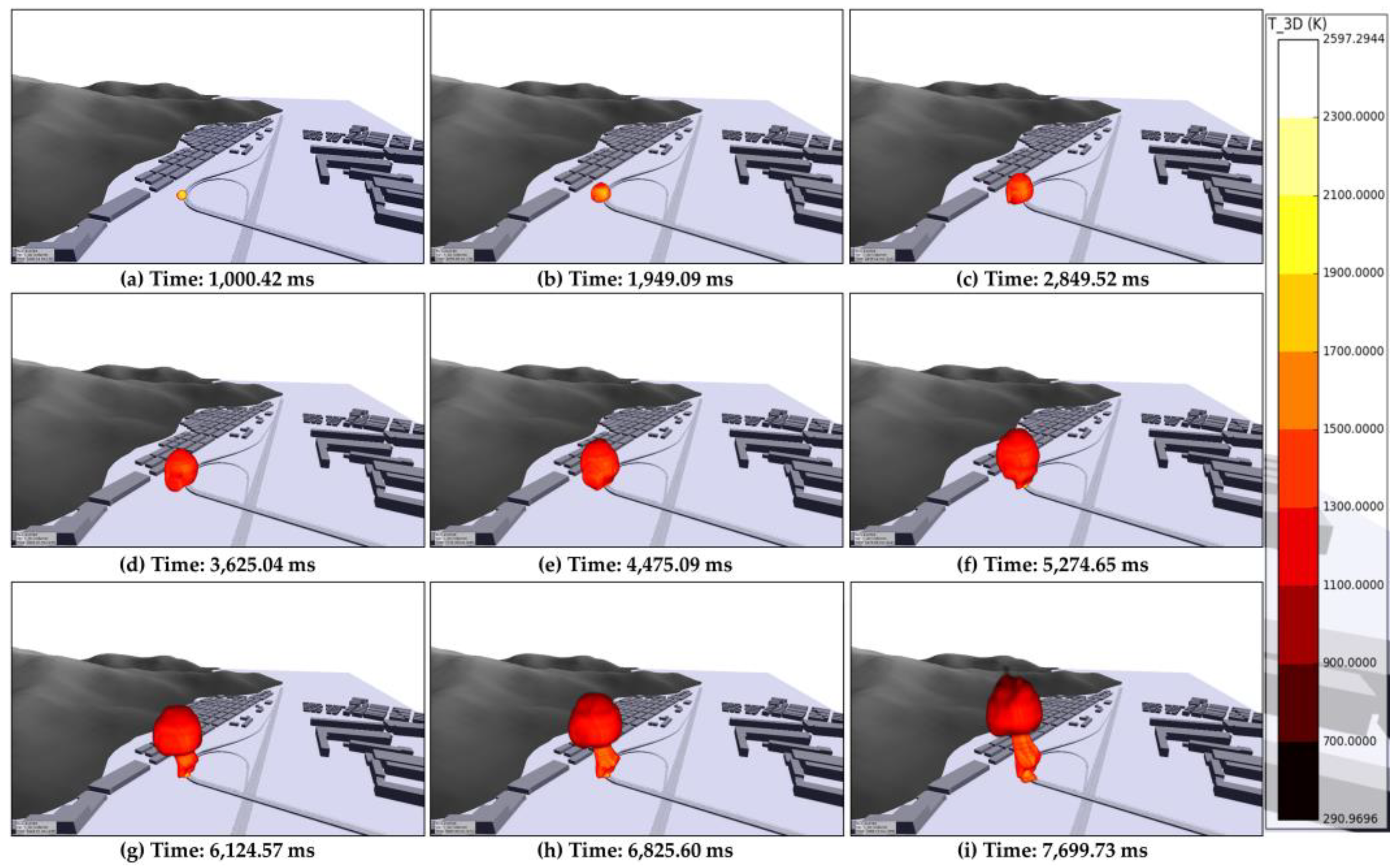
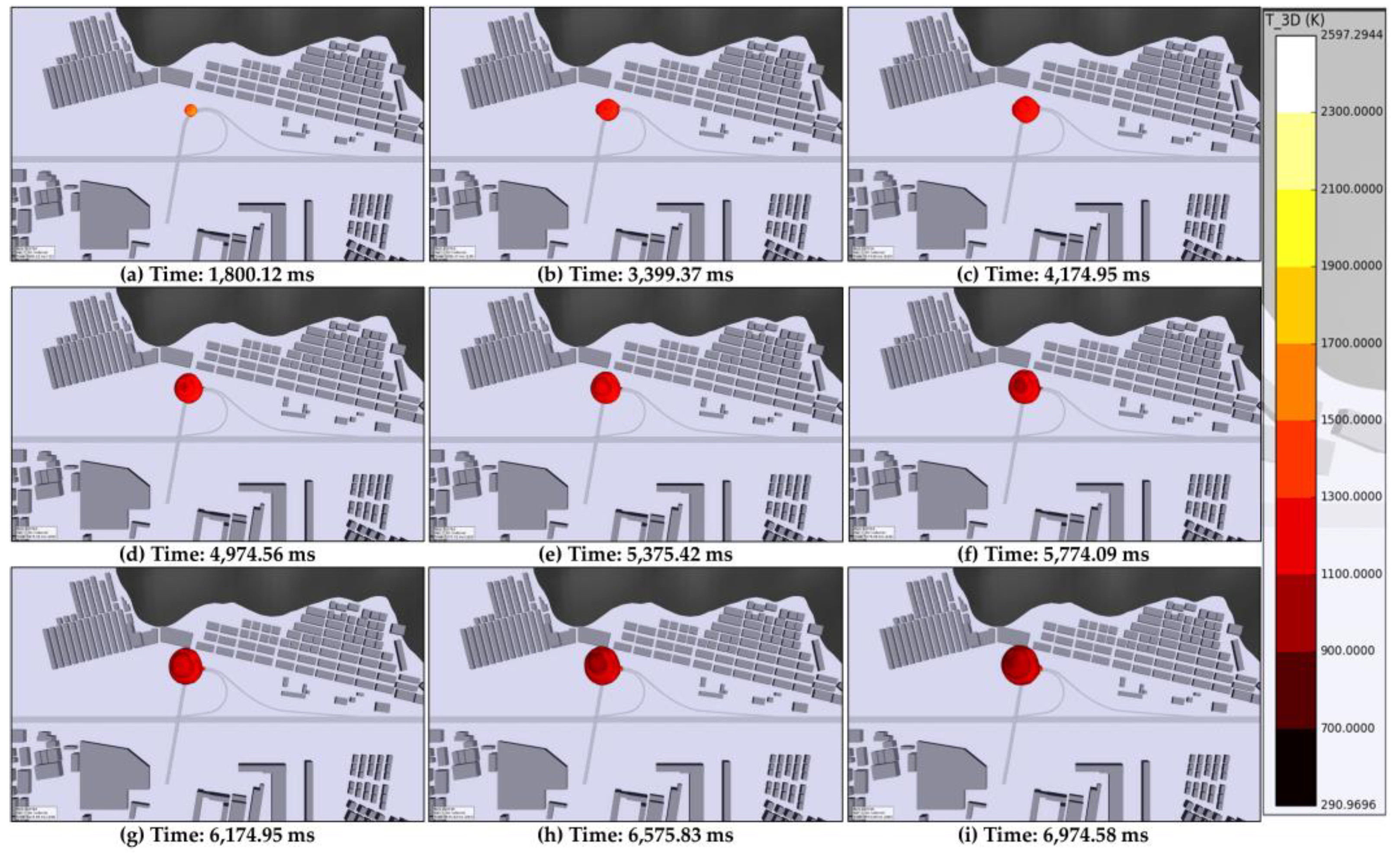
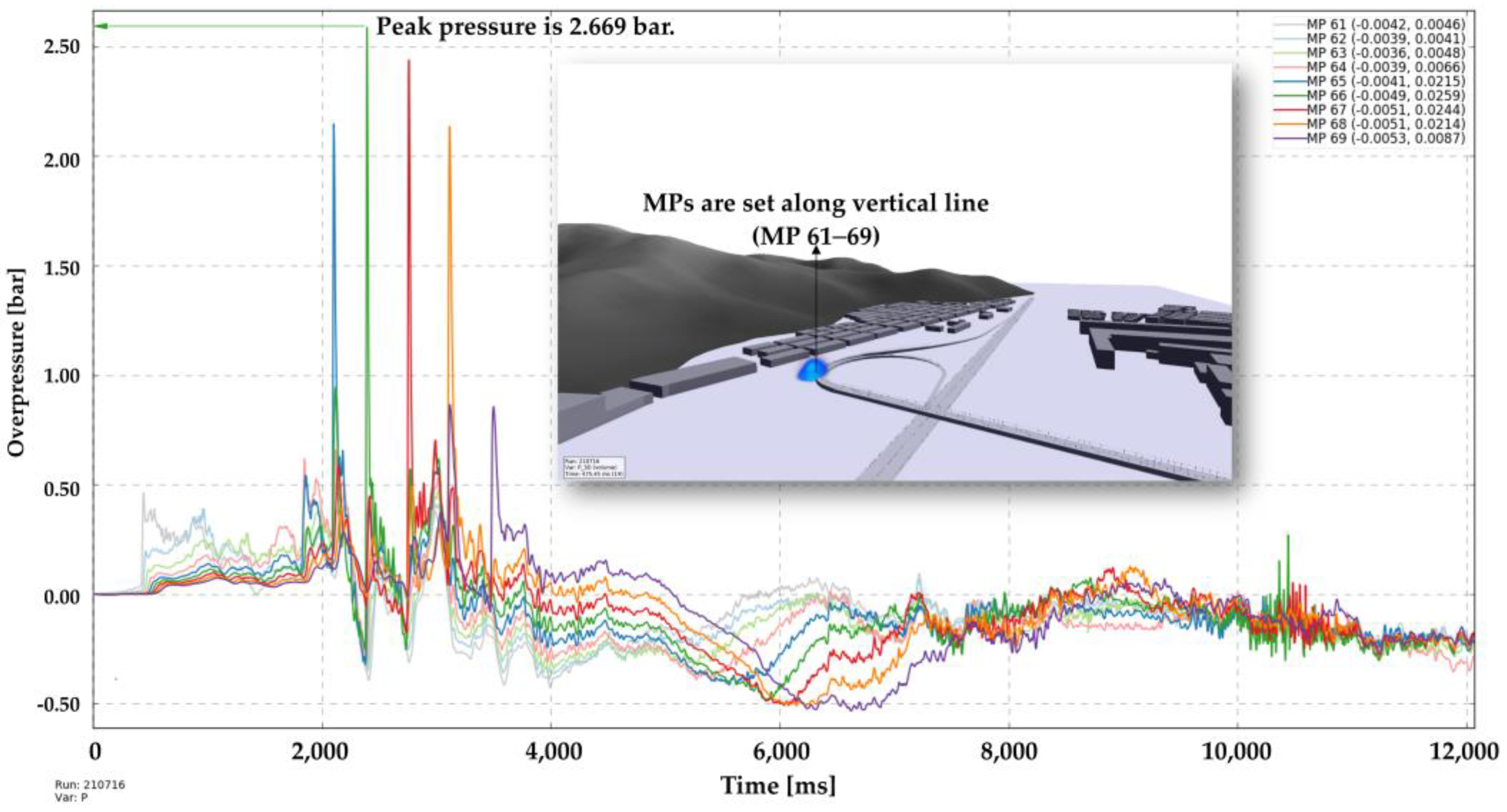
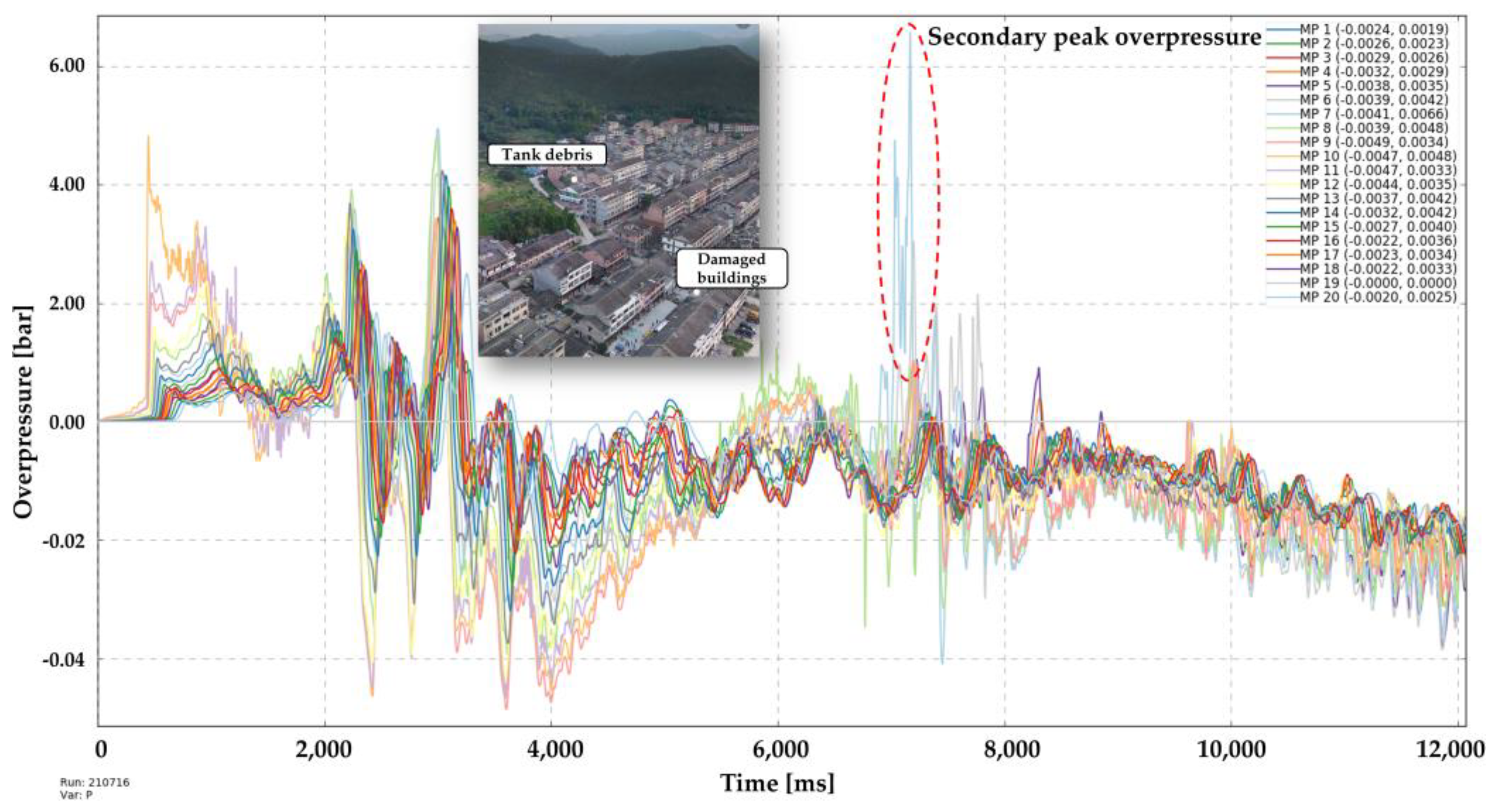
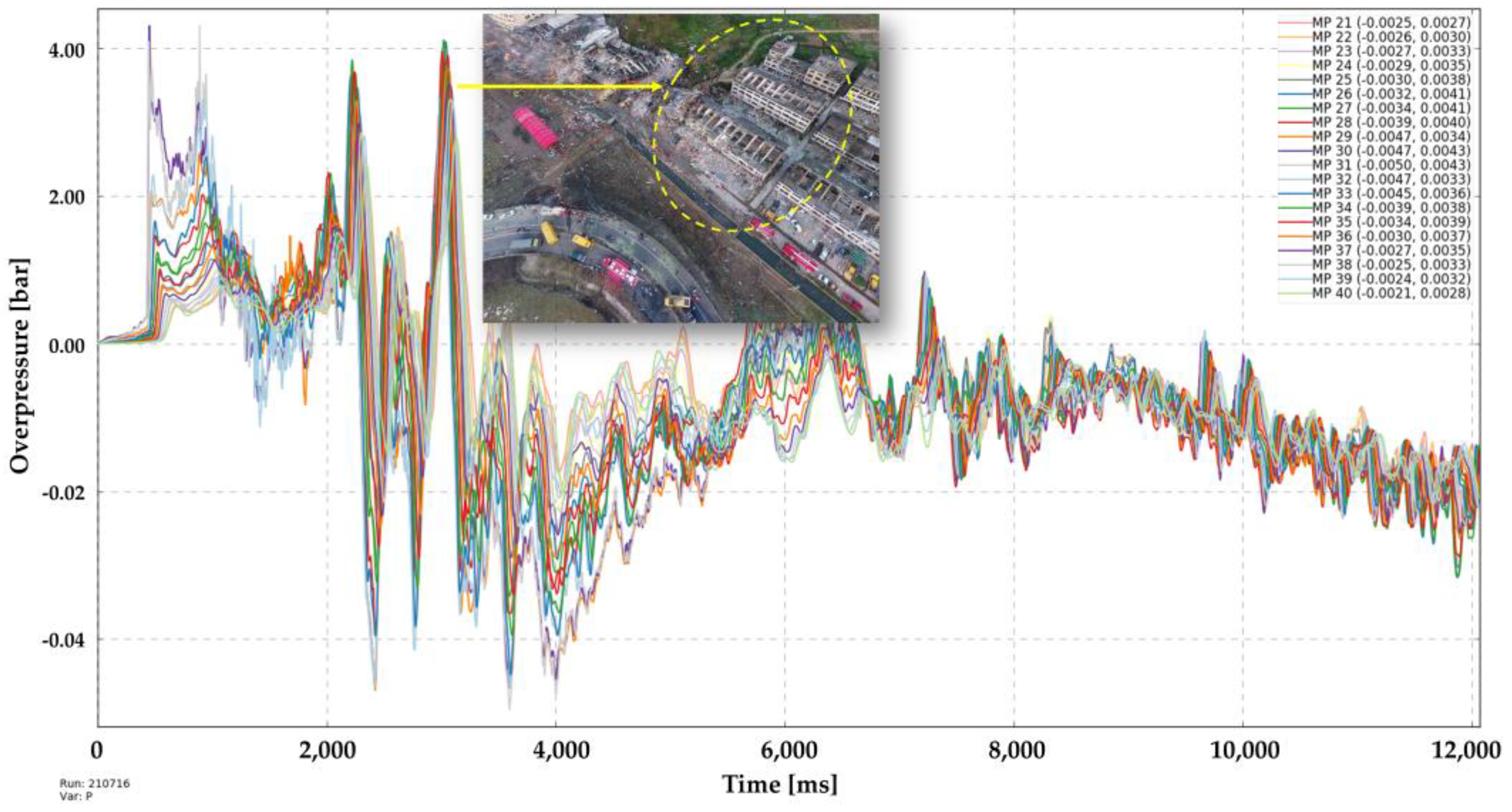


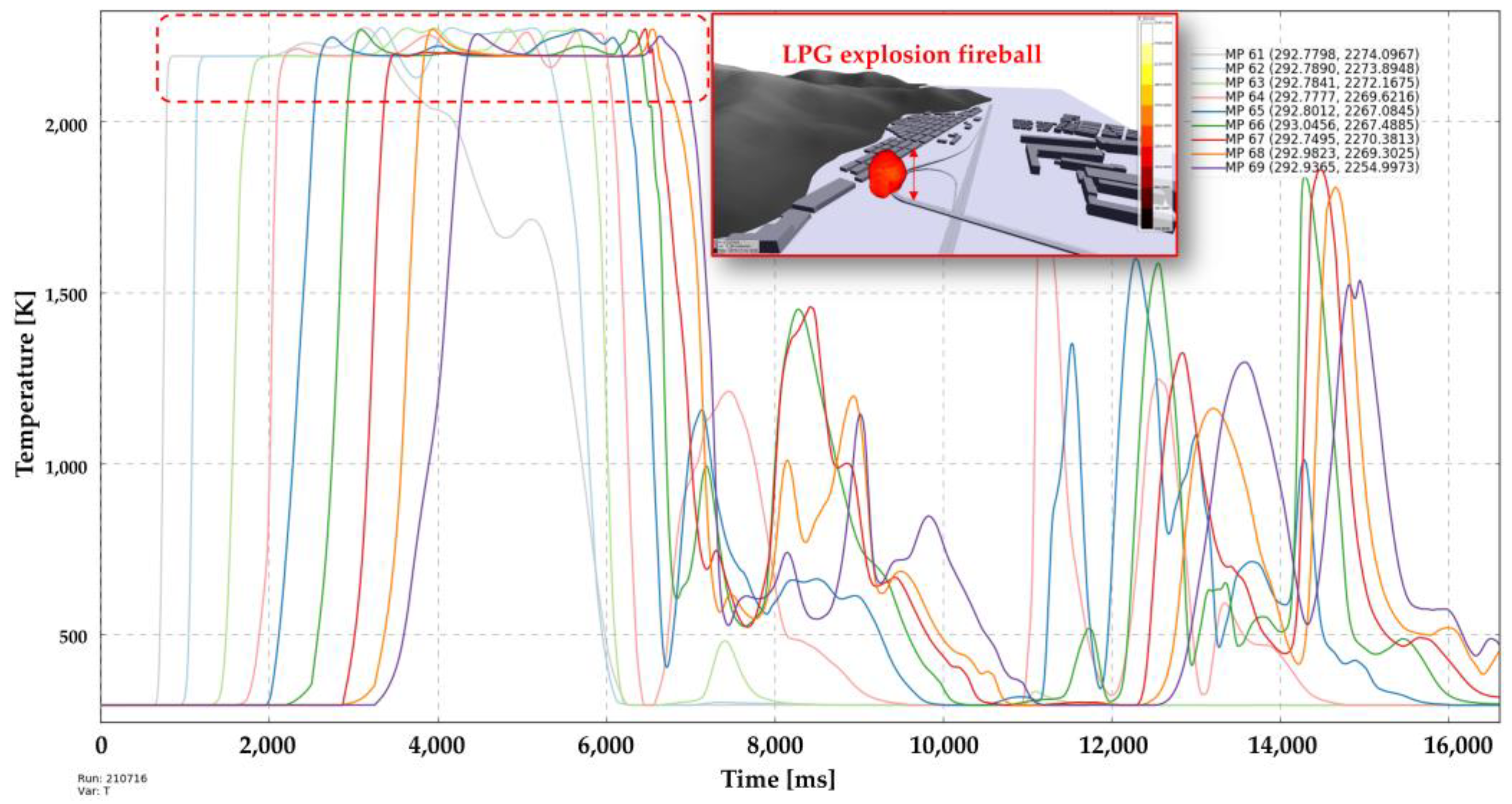

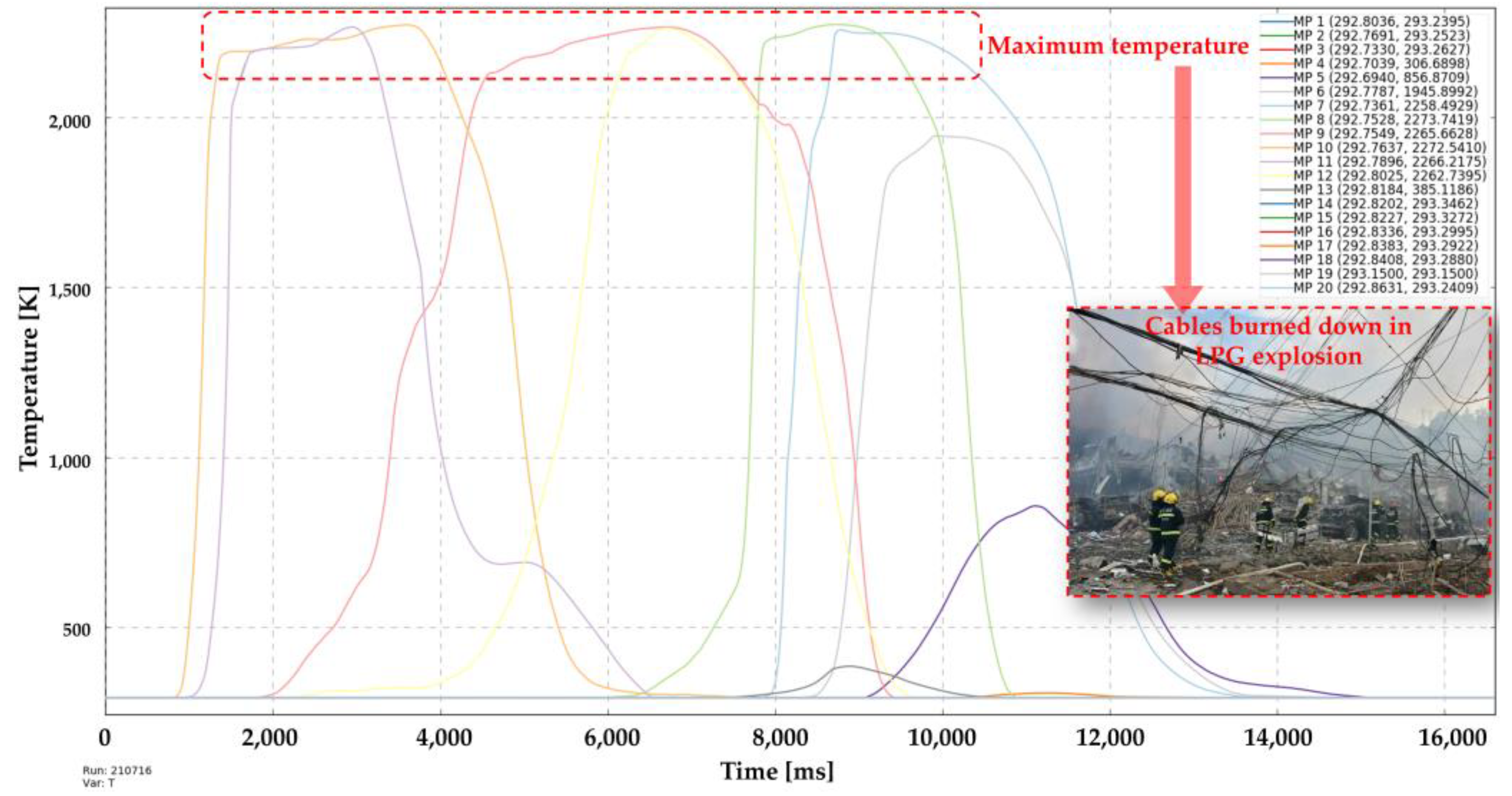

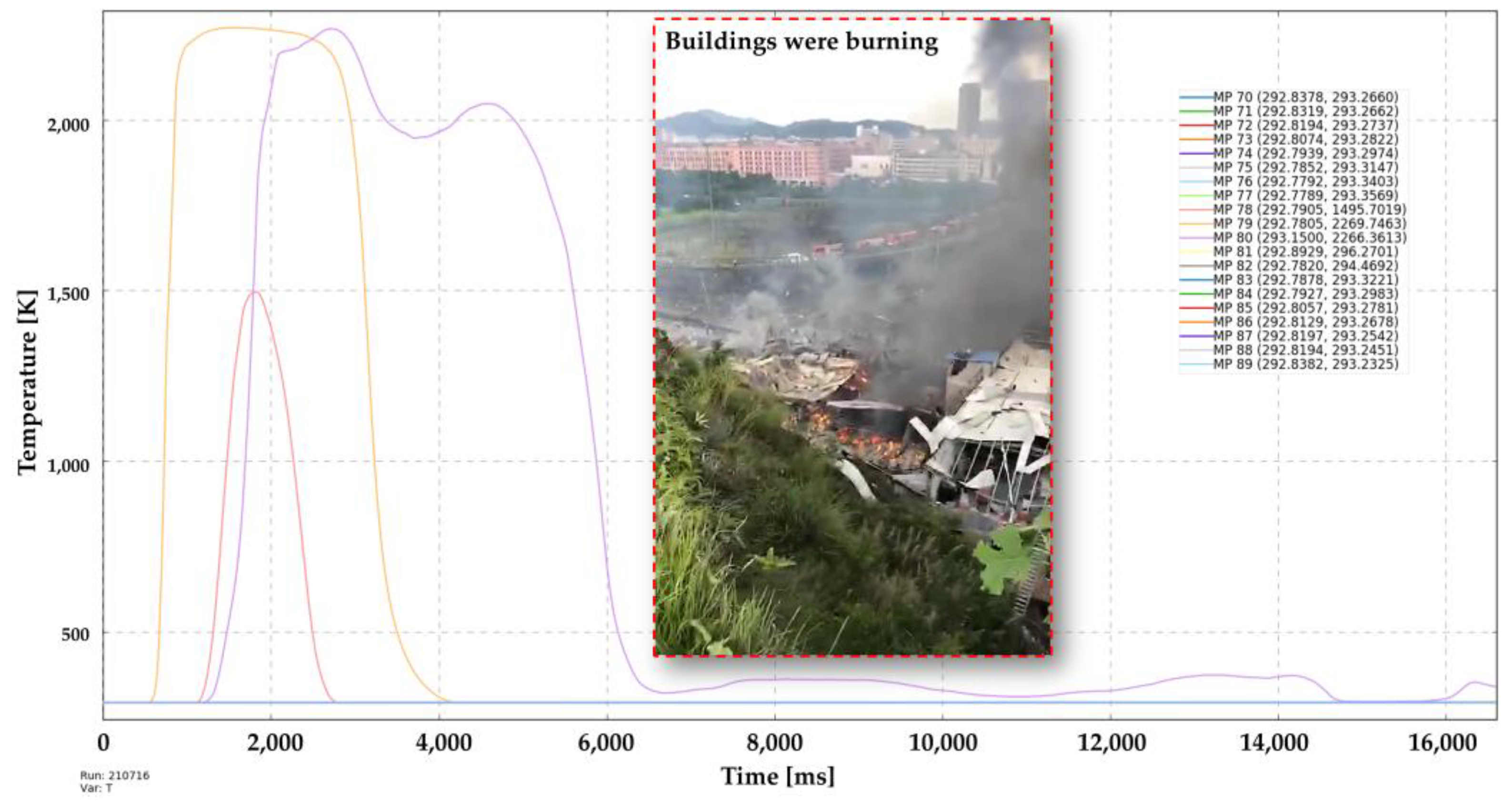
| Tank Size (m) | Pressure (Pa) | Diameter (m) | Weight (kg) | Capacity (m3) |
|---|---|---|---|---|
| 13.23 × 2.64 × 4.05 Length × width × height | 1.61 × 106 | 2.525 | 26,000 | 61.9 |
| Serial No. | Flag Number | Position Description |
|---|---|---|
| MP 61 | In the center of explosion site | |
| MP 62 to MP 69 | Vertical line, from the bottom to top | |
| MP 01 to MP 20 | 6 to 2 | Horizontal line, along the northwest |
| MP 21 to MP 40 | 5 to 1 | Horizontal line, from east to west |
| MP 41 to MP 60 | 7 to 3 | Horizontal line, from south to north |
| MP 70 to MP 89 | 8 to 4 | Horizontal line, along the southwest |
| Wind Speed (m/s) | Wind Direction | Humidity | Ambient Temperature (K) | Atmospheric Stability |
|---|---|---|---|---|
| 5.2 | South direction | 88% | 305.15 | C |
Disclaimer/Publisher’s Note: The statements, opinions and data contained in all publications are solely those of the individual author(s) and contributor(s) and not of MDPI and/or the editor(s). MDPI and/or the editor(s) disclaim responsibility for any injury to people or property resulting from any ideas, methods, instructions or products referred to in the content. |
© 2023 by the authors. Licensee MDPI, Basel, Switzerland. This article is an open access article distributed under the terms and conditions of the Creative Commons Attribution (CC BY) license (https://creativecommons.org/licenses/by/4.0/).
Share and Cite
Wang, K.; Liu, Y.; Wang, H.; Liu, X.; Jiao, Y.; Wu, Y. Dynamic Process and Damage Evaluation Subject to Explosion Consequences Resulting from a LPG Tank Trailer Accident. Processes 2023, 11, 1514. https://doi.org/10.3390/pr11051514
Wang K, Liu Y, Wang H, Liu X, Jiao Y, Wu Y. Dynamic Process and Damage Evaluation Subject to Explosion Consequences Resulting from a LPG Tank Trailer Accident. Processes. 2023; 11(5):1514. https://doi.org/10.3390/pr11051514
Chicago/Turabian StyleWang, Kan, Yang Liu, Hao Wang, Xiaolei Liu, Yu Jiao, and Yujian Wu. 2023. "Dynamic Process and Damage Evaluation Subject to Explosion Consequences Resulting from a LPG Tank Trailer Accident" Processes 11, no. 5: 1514. https://doi.org/10.3390/pr11051514





